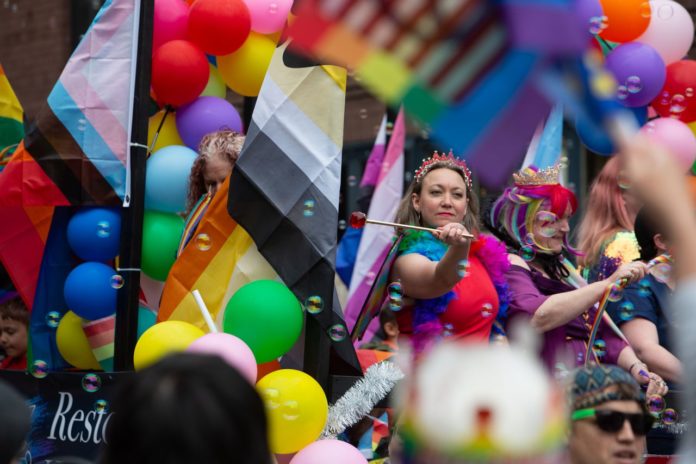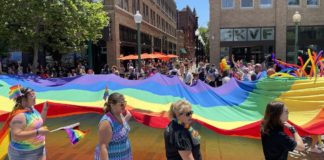
Thousands of people marched in Portland’s Pride Parade Sunday to celebrate progress that the LGBTQ+ community has made – but also to highlight challenges that remain.
“Though people may think we’re in the 21st century and have moved on, it’s even more important nowadays to come out and show our pride,” said Babylon Brooks, Levi Carpenter’s drag persona.
Babylon Brooks, who rode in the parade with the charity group Sweethearts of Portland, cited concerns about anti-gay and anti-trans bills that had been introduced in the Midwest and South, and the alleged foiled attempt by white nationalists to disrupt a Pride event in northern Idaho earlier this month.
“No matter how you try to legislate against us, no matter how you try to outlaw our existence, we’re still here,” Babylon Brooks said. “We’re not going anywhere.’’
With the roaring of the motorcycles of Dykes on Bikes at the very front, the parade kicked off at 11 a.m.
Rainbow-clad marchers, including drag queens, bikers, military veterans, faith-based groups, bands and choirs, firefighters, health providers, horse trainers and corporate employees, wound their way from the city’s Old Town neighborhood, starting outside Pride Northwest’s “Never Look Away” mural along Northwest Couch Street, to Tom McCall Waterfront Park for more than two hours.
Debra Porta, executive director of the nonprofit Pride Northwest, said the parade route shifted to highlight the mural, which features eight faces of national and local people who have actively supported the LGBTQ+ community, from national transgender rights advocate and actress Angelica Ross to retired Oregon Supreme Court Justice Lynn Nakamoto.
Porta was glad to have the parade back after a two-year hiatus due to the pandemic.
“The isolation is real for our community, so there’s nothing that beats the energy, the vibe, of being in-person,” Porta said. “Our strength in numbers reminds us that we’re not alone.”
Bolivia Carmichaels, Daniel P. Elliott’s drag persona who has entertained audiences throughout the Portland area since 1994, was the parade’s Grand Marshal.
After hosting a party Saturday night at CC Slaughters Nightclub and Lounge, Bolivia Carmichaels wore a pink sequined dress and cheered on other parade participants Sunday. During the height of the pandemic, Carmichaels hosted free weekly virtual shows, traveling performances and even a “Drag-Thru” takeout line.
“Words cannot begin to express the love that I have for our city and our community,” Carmichaels said. “It has been my life’s goal to see to it that everyone is included, recognized, supported and loved for their authentic self. This parade today, and the festivities throughout the city are our way of celebrating our individuality as well as our strength as a community.”
[embedded content]
Crowds of people at least three-deep lined the route, with some showing up more than two hours earlier to snag prime viewing spots.
Rex Daw, 62, of Portland, sat in a chair along Northwest Couch Street, by Second Avenue, reading a book at 9 a.m., waiting for the parade that would start two hours later. He said he came to cheer on his grandchildren, who were marching with a parent, an employee from Macy’s. “The gay community needs all the support we can give them,” Daw said.
Lannie Kali sat on a lawn chair along Couch Street next to spouse Maria Kali, as their 13-year-old daughter, Dania, sat on the curb in front of them.
“This is our national holiday,” Lannie Kali said. “We’re lesbian moms, and we have a bisexual daughter and a gay son.”
She said she was concerned by the arrests of white nationalist members who were accused of trying to riot at the Pride parade in Coeur D’Alene, Idaho earlier this month. “It’s still more important to be here,” Lannie Kali said. “It’s important for youth to see people like us.”
“I grew up going to Pride,” Dania added.
Marchers and parade attendees wore rainbow-colored tutus, feathered boas, socks, masks, hats and shoes.
Carl and Alison Richter’s Chinese Crested hairless dog sported a mini rainbow-colored cowboy hat, a rainbow-colored coat and a long rainbow-colored tie as he stood on a folding “Tommy Bahamas” beach chair, waiting for the parade to start.
Kat Jambor, a co-owner of the queer-run horse rescue program Once Upon a Rescue in Damascus, Oregon, painted a horse named Arrow red, white and blue before leading him through the parade.
With so much trauma experienced by people in the queer community, Once Upon a Rescue works to connect people with horses in a therapeutic manner to help build self-confidence, Jambor said.
Some marchers carried signs that read, “Trans People Belong in Sports,” “Proud Mother of a Dyke on a Bike,” and “Love is Love.” One group handed out condoms to adults in party favor bags.
Tyree Elliott usually watches the parade but this year he marched in it with fellow employees from the Beaverton marijuana shop called Green Mart. “As a black, LGBTQ guy, this place feels like home, feels like family,” he said, of his employer, where he’s worked for about eight months.
The Rev. Nathan Meckley, of the Metropolitan Community Church, said the members of the queer church have been marching in the Pride Parade since 1976. “It’s so important that gays, lesbians, trans understand that God loves us, and God has created us just as we are. We’re here to tell them they’re beloved children of God.”
Familiar faces, such as U.S. Rep. Earl Blumenauer, U.S. Sen. Ron Wyden, former Portland Mayor Sam Adams and City Commissioner Jo Ann Hardesty, were among those who joined in the revelry.
Noticeably absent were uniformed police officers or police brass, as Pride Northwest adopted a policy saying the group did not want uniformed or armed police marching.
“Because there’s a lot of symbolism in that uniform that’s incredibly triggering and traumatic for a lot of people in the community,” Porta explained. “It doesn’t take away from all of the work that LGBTQ officers have put into getting to where they’re at. But there’s a larger conversation that needs to be had because of the history and the impact on our community.”
The group’s written policy notes: “The ever-increasing use of violence against our citizens, of whom many are part of the LGBTQ+ community, is both frightening and unacceptable. While Pride Northwest remains committed to an engagement that ends the violence, we are compelled to take additional action now.”
Aside from a Portland police traffic car near the front of the parade, no Portland police group of marchers appeared.
Sgt. Kevin Allen, a Portland police spokesperson, said prior to the event, “Our involvement will be support only.’’
Robert Ball, a local real estate developer and former Portland police reserve commander who is gay and has marched in uniform in Portland Pride parades in past years with a group of police officers, called the policy change unfortunate.
“Trust comes when you engage and partner with the police,” he said. “LGBTQ+ police officers struggled to come out of the closet in the workplace and to march in the parade. Pride Northwest is trying to put LGBTQ+ officers back in the closet with this action.”
In 1991, then-Portland Police Chief Tom Potter rode in the parade to show solidarity with his daughter, Katie, a Portland police officer who had recently come out. Potter also wanted to show that the gay community that they could count on fair treatment from police, after a long history of being targeted.
Portland firefighters did show.
As firefighter Christine Pezzulo helped decorate a Portland fire truck with a rainbow-colored ribbon, she said it was important to participate in the parade.
“It shows our community that we are inclusive, that diversity is important,” Pezzulo said. “It’s vital as a fire bureau that we are represented.”
Pride Northwest had dozens of volunteers wearing fluorescent vests who helped monitor the parade route. Transit security also staged along the bus routes.
Tobyn Gendron waved bubbles at the corner of Northwest Second Avenue and Couch, as he reserved a spot for others in his LGBTQ+ Christians group to join him. Gendron, who lives in Newberg with his husband, said he’s relieved to “emerge” from the pandemic for an in-person Pride parade and festival.
“We need to celebrate who we are, and share a sense of solidarity with each other,” he said.
— Maxine Bernstein
Email at mbernstein@oregonian.com; 503-221-8212
Follow on Twitter @maxoregonian








